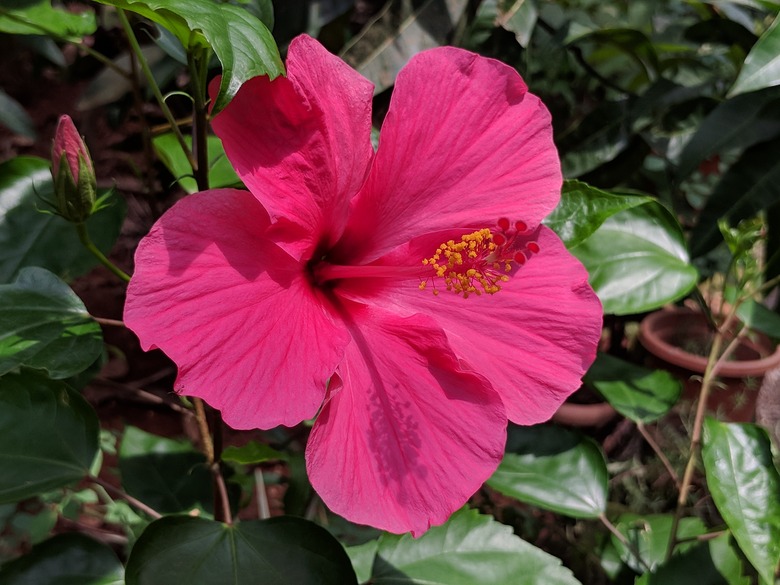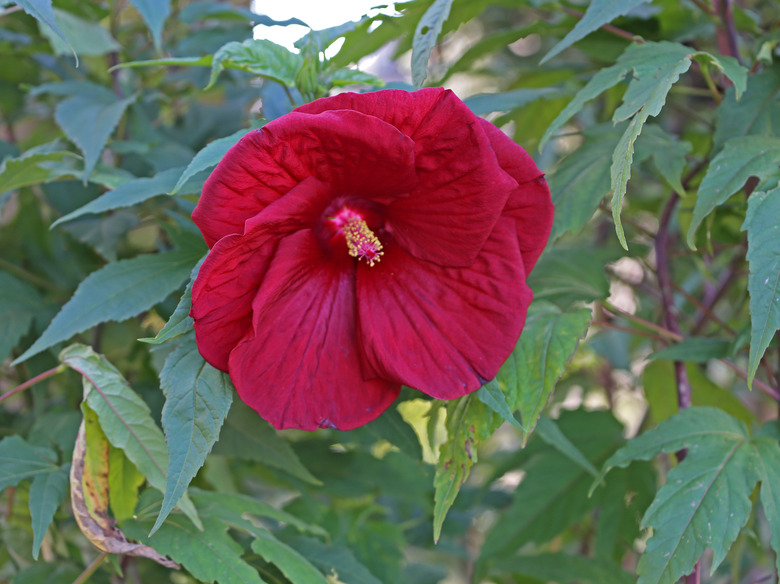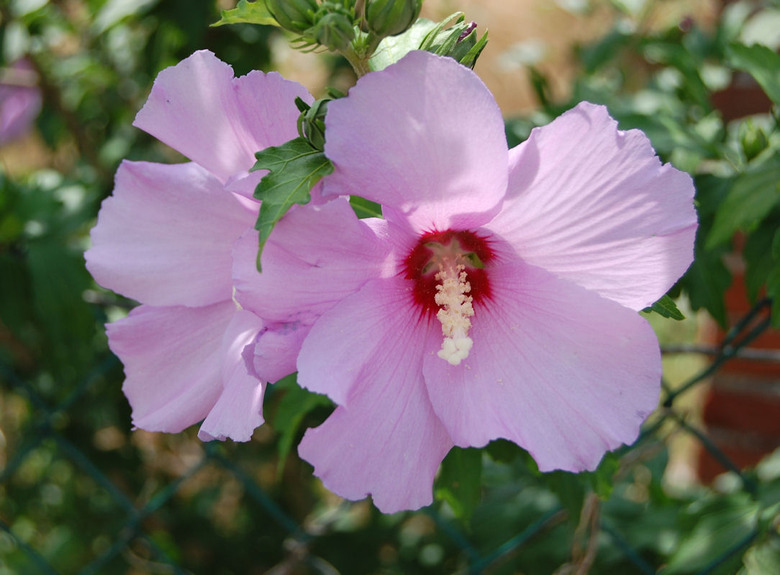How Do I Tell If The Hibiscus Bush I Just Bought Is Perennial Or Tropical?
The cool thing about hibiscus (Hibiscus spp.) is that even if it's a non-tropical variety, it brings the tropics to your landscape with its sumptuous, velvety petals and flowers in a trumpet shape.
If you have just purchased a hibiscus, how can you know if you have a tropical hibiscus (Hibiscus rosa-sinensis) or a hardy hibiscus, a categorization that includes multiple species?
One way to tell if you just bought the plant is to find the plant tag, because anything other than H. rosa-sinensis is a hardy variety, meaning that it will die back in the winter but return in full force in the spring.
What if you already have the plant home, can't find the plant tag and the clerk at the nursery can't help you? What are the defining characteristics between the hardy and tropical varieties? First and foremost, consider the climate.
Tip
The easiest way to tell the difference between tropical and hardy hibiscuses is to look at the leaves. Tropical hibiscus plants have glossy, dark-green leaves, while perennial hibiscuses have duller leaves that are matte-like and less green—and they often have serrated edges.
Weather and Location Offer a Big Hint
A primary indicator as to which hibiscus you have is your location. If you live in a non-tropical area and have just purchased a hibiscus at a local nursery, it will almost certainly be a hardy hibiscus unless you nabbed it out of a greenhouse.
No tropical hibiscus could make it through the winter in climates colder than USDA plant hardiness zone 9. If it's winter and the hibiscus still has leaves, it's a hardy hibiscus, for sure—although, if it is cold-damaged, its leaves will fall off, and some or all branches may die back.
If it's summer and your hibiscus is going gangbusters, it could be either. Let's explore the ways hardy hibiscus, also called perennial hibiscus, differs from tropical hibiscus when they are both leafed out and flowering.
Hardy vs. Tropical Hibiscus Comparison
Several clues can help you identify the type of hibiscus you are looking at. Here are the primary ways:
First Look at the Leaves
A dead giveaway to the tropical vs. perennial determination is the look of the leaves. Tropical hibiscus plants have glossy, dark-green leaves, while perennial hibiscuses have duller leaves that are matte-like and less green. They often have serrated edges.
Consider the Flowering Season
Perennial hibiscuses flower in late summer to early fall—they are among the last of the summer flowers to bloom. So if you are looking at a fully-blooming hibiscus in June, it's likely a tropical variety. Typically, tropical hibiscus plants flower from spring to fall.
Admire the Flowers
Hibiscus tropical flowers look, well, tropical. They tend to be large and showy in a wide range of fabulous colors, including colors not normally seen in hardy hibiscuses, such as salmon, yellow, peach or multi-hued. They frequently have double blooms, also unusual in perennial hibiscus.
The flowers of hardy hibiscus differ depending on the species and hybrid. For example, H. moscheutos and its cultivars can have enormous blooms up to 10 inches in diameter. Rose of Sharon flowers are usually about 3 inches in diameter with five petals surrounding white stamens tipped in yellow. H. coccineus flowers are always red, while H. mutabilis flowers start out white and change to pink or dark pink as the day progresses.
Common Hardy Hibiscus
Most hardy hibiscus plants are herbaceous, although they are winter-hardy, meaning that their stems die back to the ground each year. One type, however, commonly called Rose of Sharon, is a woody hibiscus, meaning that it retains its branches and structure in winter.
Further, the term "hardy hibiscus" usually refers to one species, H. moscheutos, even though there are multiple winter-hardy species.
Multiple hybrids exist for each species, but here's a rundown of the primary species you're likely to find in the U.S.:
Hardy Hibiscus Species
| Hibiscus | Botanical Name | Hardiness Zone | Description |
| Rose of Sharon, althea or "shrub" hibiscus | Hibiscus syriacus | Zones 5 to 9 | Woody; 8 to 12 feet tall; red, white, pink or lavender flowers. |
| Crimson-eyed rosemallow, swamp rosemallow or "perennial" or "hardy" hibiscus | Hibiscus moscheutos | Zones 5 to 9 | Herbaceous; 6 to 7 feet tall; white, pink or red flowers. |
| Scarlet rosemallow | Hibiscus coccineus | Zones 6 to 9 | Herbaceous to semi-woody; 3 to 6 feet tall; red flowers. |
| Confederate rose | Hibiscus mutabilis | Zones 7 to 11 | Herbaceous to semi-woody; 12 to 15 feet tall; white fading to pink. |
References
- Proven Winners: Top 10 Hardy Hibiscus From Proven Winners
- University of Florida IFAS Extension: Hardy Hibiscus for Florida Landscapes
- Frontiers in Plant Science: Phenotypic Similarities in Flower Characteristics Between Novel Winter-Hardy Hibiscus Hybrids and Their Tropical Relatives
- Florida Wildflower Foundation: Scarlet Hibiscus
- Texas A&M Agrilife: Hardy Hibiscus
- Smithsonian: Care of Hibiscus Rosa-Sinensis
- The Tropical Hibiscus: Growing Tropical Hibiscus Up North


